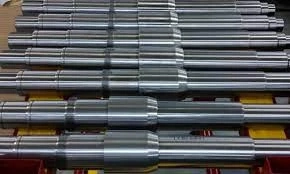Importance of Pump Shafts
Pump shafts serve as the critical link between the motor and the impeller, enabling the transfer of rotational energy to create fluid flow. Their precise design and construction are essential to ensure the pump's smooth and efficient operation across different applications. The reliability and performance of pump shafts significantly impact the overall effectiveness of pumping systems, making them a crucial consideration in engineering design.
One of the key functions of Pump Shafts is to transmit torque from the motor to the impeller, allowing the pump to generate the required flow and pressure. The shaft must have sufficient strength and rigidity to withstand mechanical forces and torsional stresses. Furthermore, pump shafts must exhibit excellent dimensional accuracy and balance to minimize vibration, reduce wear on bearings, and ensure optimal pump performance.
Pump shafts also play a role in facilitating maintenance and repair processes. Their design should allow for easy disassembly and replacement, enabling efficient servicing and minimizing downtime. Proper material selection and surface treatment of pump shafts contribute to their longevity, reducing the frequency of replacements and associated costs.
Applications of Pump Shafts
Pump shafts find extensive use in various industries and applications. They are commonly employed in centrifugal, reciprocating, and rotary pumps. In the water and wastewater industry, pump shafts are integral to water treatment plants, sewage systems, and irrigation systems. They also play a crucial role in industries such as oil and gas, mining, manufacturing, and HVAC systems, where fluid movement and circulation are vital.
In addition to their industrial applications, pump shafts are used in residential and commercial settings. They are essential components of household water pumps, swimming pool pumps, and spa systems. Pump shafts are also utilized in heating and cooling systems, including heat pumps and air conditioning units, ensuring efficient circulation of fluids for temperature control.
Furthermore, pump shafts are employed in the agricultural sector for irrigation purposes. They are integral to agricultural pumps for watering crops, maintaining optimal soil moisture, and promoting agricultural productivity. The durability and reliability of pump shafts are crucial in agricultural applications, where continuous operation and performance are paramount.
Materials and Considerations in Pump Shaft Design
Various materials are used to manufacture pump shafts, each offering specific advantages based on application requirements. Common materials include stainless steel, carbon steel, and alloys such as bronze and brass. Stainless steel is favoured for its corrosion resistance and strength, making it suitable for chemical, pharmaceutical, and food processing applications. Carbon steel exhibits good mechanical properties and is often used in industrial and wastewater applications.
Engineers must consider factors such as shaft diameter, length, and material properties when designing pump shafts. The shaft diameter is determined based on the torque and power requirements of the pump, ensuring sufficient strength to handle the transmitted forces. The length of the shaft is determined by the pump's design and the distance between the motor and the impeller. Material properties such as hardness, tensile strength, and fatigue resistance are crucial in ensuring the longevity and reliability of pump shafts.
Surface treatments and coatings are often applied to pump shafts to enhance their performance and protect against wear and corrosion. Common treatments include heat treatment, plating, and specialized coatings. These treatments improve the surface hardness, reduce friction, and provide additional resistance to corrosion and abrasion, thereby extending the lifespan of pump shafts.


